Wood-Burning Stoves: Plenty to Choose From Whether Old or New
Like the sun itself, a hearth fire or wood-burning stove radiates heat directly onto the human body. When you and your family cluster by the fireside on a frosty winter evening or gather near the cheery warmth of your stove, you will experience a satisfaction and comfort that modern central heating fails to equal. You will also be enjoying the only form of indoor heating that the human race has known for thousands of years.
Though they are charming and sometimes a bargain to operate, wood-burning devices require attention. Fuel must be replenished, draft regulators and dampers have to be set, ashes must be removed, and the chimney must be cleaned out. Though drudgery for some, many people take pleasure in these chores, enjoying the direct hand they have in the control of their environment.
If you have never tried heating your home with wood, proceed gradually. For example, you might start with one stove, installed to heat one room, leaving the rest of the house to be heated by a more conventional system; in this way you can learn the virtues and idiosyncrasies of wood burning and be able to plan intelligently any expansion of its use. You may discover, for example, that wood burning might work well in conjunction with a solar energy installation, the former doing most of the job in midwinter, the latter handling the load in spring and autumn.
Making it easier for you is the wide array of wood-burning devices on the market today, most of good design, high efficiency, and excellent workmanship. With these at your disposal, you are likely to find the right stove fi)r your situation whether you look for economy, esthetic pleasure, or a combination of the two.
Stoves of the Past
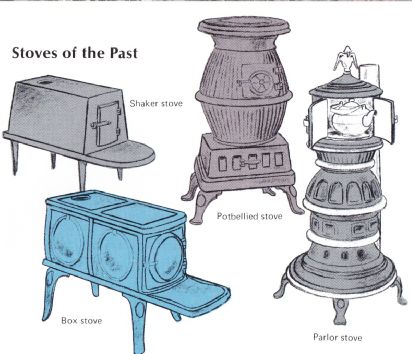
------ Stoves have been used to warm homes for centuries,
but until recently, particularly in America, they took second place to fireplaces.
In the 19th century, however, the development of techniques to produce cheap
cast-iron plate helped iron stoves become the most popular home-heating devices.
Hundreds of firms marketed stoves in a fantastic variety of shapes.
Iron stove design began with the box and the cylinder. A famous early version was invented by Franklin (see below). Despite the merits of his stove, it was soon supplanted by models that stood on legs and could be placed anywhere in the house rather than being tied to an existing fireplace or requiring special floor construction. At their peak iron stoves could boast of ash pits, built-in chambers for teakettles, secondary combustion chambers, and a lively baroque decor.
Ben Franklin's improved fireplace
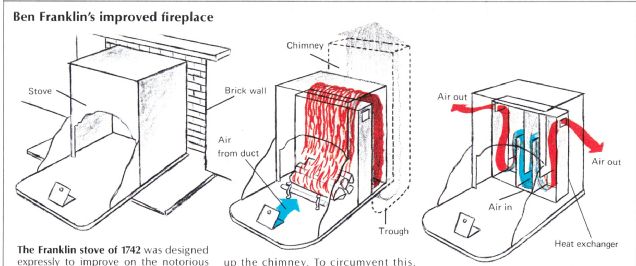
----------- The Franklin stove of 1742 was designed expressly
to improve on the notorious inefficiency of old-time fireplaces. It was an
immediate success, gaining popularity during Franklin's lifetime and in influencing
stove design for years to come. Not however, that the original Franklin should
not be confused with what are now called Franklin stoves; the two types have
little in common.
Fireplaces waste heat by sucking heated air from the room and sending it up the chimney. To circumvent this, Franklin blocked the chimney opening with a brick wall. To let smoke exit, he fitted a trough beneath the wall so that the smoke from his stove could exhaust under and up behind the wall. A damper inside the stove controlled the rate of exhaust. Fresh air was drawn from what ever space was under the floor (a cellar, br example) via a duct cut through the floor; the duct opened onto the fire.
To improve the stove's efficiency, a hauled heat exchanger was placed be tween the fire and the back of the stove. Air to the exchanger was channeled from under the floor in the same way as the fresh air for combustion was channeled. The air in the heat exchanger absorbed heat from the fire and exhaust, passing out into the room via two ports, one on each side of the stove.
Modern Stoves
Recent developments in stoves have been mainly technological, an attempt to design a stove that will squeeze the last calorie of heat out of the wood being burned. Although there are many models on the market, no one stove can be singled out as generally superior to the rest. The best stove for you will depend on your personal taste, the purpose for which the stove is to be used, and on 1mw the stove is installed and operated.
Ii en the standpoint of efficiency, a good stove should 'ii draw any more air than that needed for the wood tiul 11w gases given off by the wood to burn. Fireplaces, for example, for all their appeal and hominess, do not boy this rule. They gulp large amounts of unneeded air. I iii:i ny homes, this air comes down the furnace and wut t heater chimney to create a potentially dangerous oil in ion. Building codes or home insurance agents may I iipiire installation of a make-up or combustion air ' 't'o minimize this problem with stoves, many man " iii I ii rers make them airtight, meaning that the stoves iii ii well sealed and free of chinks that the air flow i I i adjusted to the exact rate needed. You can even "liirvr the fire of oxygen and make it go out. An inciden l inlvantage of airtight stoves is that they can be left oled for many hours, even overnight, while contin l to generate warmth at a fairly constant rate. Another attribute of a good stove is that it transfers Ii,'iit to the house rather than letting it go up the Iuiiiiiiey. To accomplish this, a system of chambers or I is usually built into the stove. The hot air, smoke, jitil gases are channeled through the chambers or past It baffle walls. These, in turn, absorb the heat and tiitliiit.r it into the room. There are a variety of stove ,ii'iililications using this principle, some as simple as the iiigle horizontal baffle-plate design used in such Euro pean stoves as Lange, J 1}olla, and Morsp; others with complex air-flow arrangements supported by secondary air inlets, as in the American-made Defiant, Tempwood, and Ashley stoves.
As an added convenience, some stoves have a built-in thermostat; you set it for a particular temperature and the thermostat takes over, opening and closing the draft regulator (adjustable air inlet) to control the rate at which the fire burns. On stoves without a thermostat it is up to you to adjust the regulator to get the desired burn rate; you will learn by experience how to set it. To maintain a fire overnight, the regulator should be opened only a crack. Note, however, that slow burn rates can result in creosote buildup in the chimney (see The Creosote Problem, p.91).
Some home heating units combine a wood-burning furnace with a conventional hot air system of the sort used with natural gas or oil burners. These have the advantage of heating the entire house with a single unit instead of with a number of stoves or fireplaces distributed in different rooms. Also, wood can be stored and dried in the basement, next to the furnace, minimizing handling and keeping the rest of the house free of wood chips. Countering these advantages, however, is the kind of heat provided; most people find the radiant heat of a stove more comfortable than warm air from a register.
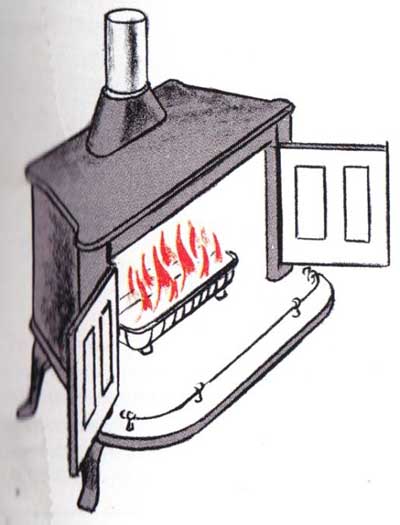
----------- Franklin stoves as made today are only remote descendants of Ben Franklin's original design. The modern version amounts to a straightforward cast-iron stove, with doors in front that open to let you view the fire-a feature Franklin himself strove to keep. With doors closed the stove gains in efficiency but not up to the level that well-made airtight stoves attain.
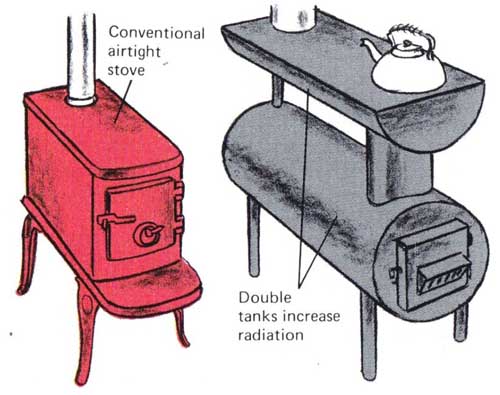
-------- Airtight stoves have top ranking for fuel savings, simple construction, ease of use, and long life. The design has been popular in Scandinavia for some time, and now American manufacturers, such as Fisher and Sunshine, make airtight units as well. One version, by Sevca, is built from a pair of empty propane tanks and features a separate smoke chamber above the fire chamber that extracts heat from the exhaust smoke and reradiates it into the room before it is lost up the chimney. The flat shelf shown offers a warming surface for the teakettle.
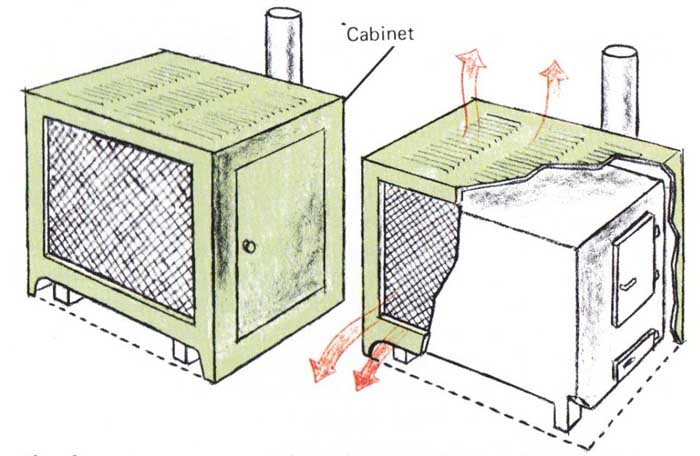
-------- Circulator-type stoves, such as those made by Ashley and Rite- way, are fabricated from steel plate and feature a cabinet (optional with some units) that surrounds the stove proper. Air between stove and cabinet heats up and is circulated out into room either naturally by convection or by a blower. A thermo statically controlled draft regulator is part of the design. Well-made units approach other airtight stoves in efficiency, but the warm air produced by the cabinet-enclosed models is generally not as pleasant as heat from radiant stoves.
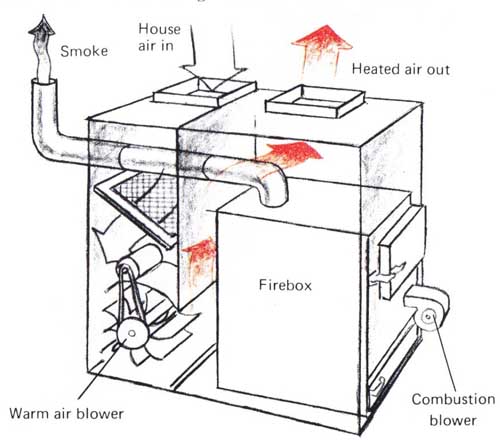
-------------- Wood-burning furnaces (see picture below) are essentially overgrown circulator stoves; their larger size is needed to accommodate the heating requirements of an entire house. They are normally installed in the cellar, just as an oil burner would he, and blow heated air through ducts to the rooms above.
Selecting and Installing A Wood-Burning Stove
Choose a stove whose capacity matches the heating requirements of the space you intend to heat. A stove that is too small will have to be refueled frequently and still may not generate enough warmth. An overly large stove can be even worse, causing overheating on all but the coldest days, and more creosote build up from general use.
Manufacturers usually specify the heating characteristics of a stove iii terms of the number of rooms or the number of cubic feet of space the stove can heat. In a few cases they give the heat output in BTU's per hour. An average-sized room contains about 1,500 cubic feet. When the temperature outside is at the freezing level, you should be able to heat such a room with a stove that puts out 15,000 BTU's per hour. Of course, there are many variables to consider. How well insulated and weatherproofed is your house? (The better your house retains heat, the smaller the stove you will need.) Is your home laid out ranch style or does it have a compact two-story design? (It is easier to heat a compact house than a sprawling single-level home.) What sort of wind velocities are typical in winter? (The more wind, the bigger the stove you will require.) Above all, you must consider the severity of the winter in your area. A stove that will function admirably in Maryland or Arkansas may work only marginally in New York, Kansas, and eastern Oregon and be totally inadequate in northern Maine, Minnesota, Montana, or Alaska.
Though a central location for the radiant heat unit is advisable, other considerations such as chimney location may take precedence. Bear in mind that you will frequently be transporting firewood into the house; the trail of dust, mud, and wood chips that usually follows a trip from woodpile to stove can become a nuisance. To shorten the trail, place the stove near the doorway through which the wood will be brought or install a through-the-wall woodbox.
Buying a used stove Not very long ago it was easy to find a discarded cast-iron parlor stove or cooking range. Now, however, these have become treasured antiques, and unless you are lucky they will cost you as much as a new stove.
Besides being attractively designed, old stoves were made to last; however; many were built to burn coal rather than wood, so their fire-boxes tended to be smaller.
Wood can be used in a coal stove, but you must cut it into shorter pieces and load the stove more often.
If you come across a stove you like, examine it care fully for cracks, particularly in the firebox. Cracks are responsible for inefficient operation and will cause the room to smoke up when the stove is started. Sometimes a cracked firebox can be fixed by welding or brazing, but this must be done by a specialist-repairing cast iron is a very tricky business. Cracks found in other parts of the stove, where the operating temperature does not rise as high, can be chinked with stove putty.
Before buying an old stove, be sure you will be able to replace essential parts, such as grates and doors, that happen to be warped, broken, or missing. There are a number of stove works around the country able to provide parts or cast new ones for you. Be wary of stoves that show signs of extensive rust. Surface rust can be removed with a wire brush followed by the use of stove black, but if vital inner parts are corroded, you may find it difficult or impossible to repair them.

------ Radiant stove will heat most dice and esent if it is bc ated toss ar center of thc house ( cnt ral place of rc olalor type stoves is less i tant; put them where they ran laki advantage ol natural air how pattc.
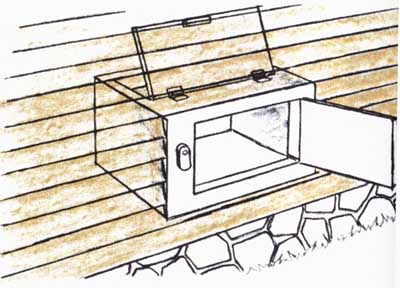
--------- One style of woodbox: Through-the-wall woodbox conserves heat because y not have to open ho door to fete h eac h load of v Keel) interior of box dry to help pres cot insect infestati oi ss ood rot. Wea thcrstri p both rloors.
Chimney Installations
A properly designed and installed chimney will produce a strong, even draft through the stove without any backpuffing (smoke coming out of the stove). Backpuff log occurs when the chimney has the wrong capacity or too many bends in the way of the smoke path. The capacity of a chimney is determined by its height and inside diameter; the higher and wider the chimney, the more capacity it has. When the capacity is too small, the stove will smoke whenever you try to raise its heat output by opening the draft regulator beyond a certain point. When the capacity of the chimney is too large, smoking can also occur, since the rising smoke-saturated iii loses too much heat to the chimney surface. As a result, the air rises more slowly, generating a back pressure whose effect is visible as backpuffing. Back pulling can also result from inadequate clearance at the chimney top; a chimney should be at least 3 feet higher than any object within 10 horizontal feet of it.
Usually, smoke problems arise only when you connect to an existing chimney. Typically, a masonry chimney may have too large a capacity; a metal chimney, too small a capacity. Do not connect to a chimney already used by another stove or fuel burner. When installing a new chimney, match the inside diameter of the chimney to the diameter of the stove's exhaust flue.
A safe installation is vital. You risk burning down your house if an uninsulated stovepipe touches or passes near a part of the house made of wood or other flammable material. Manufacturers of prefabricated chimneys give installation guidelines, but check building code requirements for your area also.
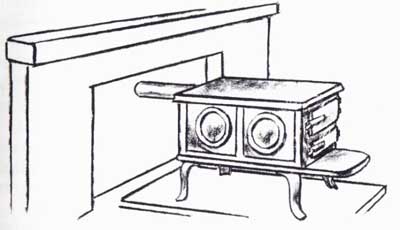
---------- Using a fireplace chimney: To connect a stove to an existing fireplace chimney, remove fireplace damper and frame. Install stainless steel liner in chimney and extend above the chimney. Seal with sheet metal where exits damper throat. Fill between liner and masonry chimney with hi-temp insulation or cement slurry. Seal top of liner with sheet-metal and add proper cap. Connect the stove collar.
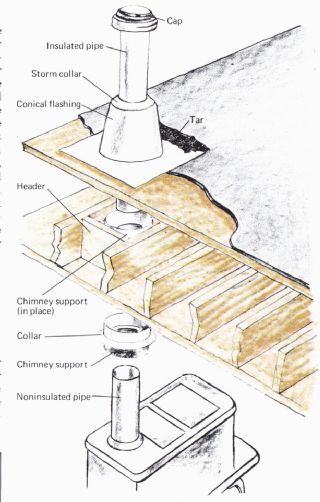
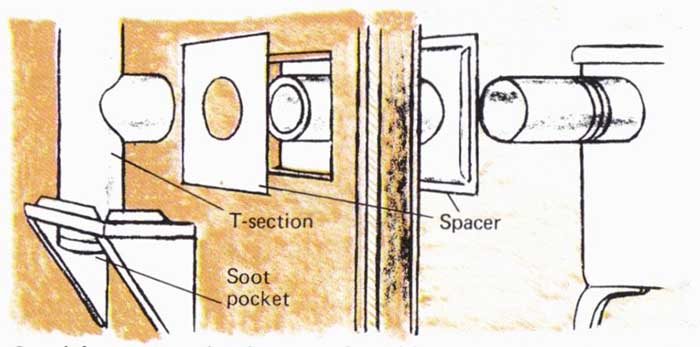
----------- Special spacer made of non-combustible material must be used to support any stovepipe that passes through a frame wall. A useful addition is to install T-sections with soot pockets and cleanouts in place at ordinary 90-degree bends in stovepipe.
Installing a pre-fab chimney
1. Set stove in desired position, then use plumb bob to find center of hole that will be cut in ceiling for chimney. Ideally, chimney should pass through gap between roof beams. To locate beams, tap ceiling.
2. Draw a square on ceiling around center mark just large enough to accommodate chimney support (for example, 11 by 11 in. for 7-in. diameter flue),
3. Cut square out of ceiling with compass saw.
4. Drill guide hole up through roof at one at four corners at square opening.
5. Working on top of a roof, use guide hole to help draw and cut out a square hole centered on hole in ceiling below hut in. larger in each dimension (14 by 14 in. for the example here).
6. Saw through any beams that block 11 by 11-in. opening.
7. Cut headers to fit opening, then nail them in place between roof beams. Drive in nails at 45 degree angle
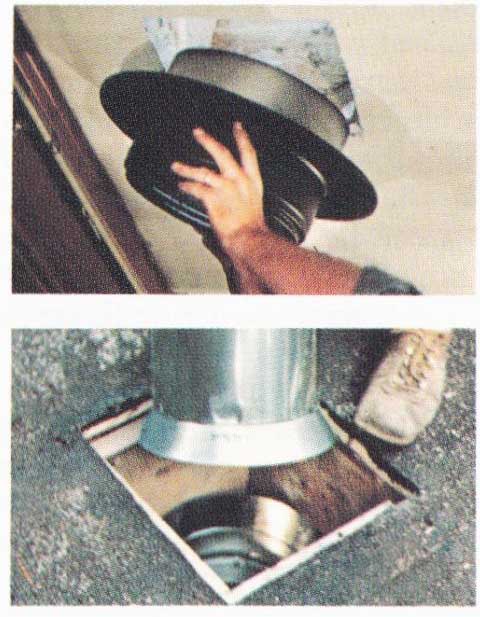
8. Lift chimney support into hole in c c'i ling froni below Fast en support to ac c'nt beams and headers by hammering c ghtpenny nails through collar of support into beams and headers
9. Lower insulated pipe section into chimney support from root (The sec lion simply rests in support; conic ,tl flashing plac cc later will restrain sect 0)0 from toppling.)
10. Apply liberal amount of roofing tar to roof around 14- by 14-in hole. Slip conical lashing clown ooto tarred area
11. Add additional section ot insulated pipe; then tighten hand t hat locks sc'c lions together.
12. Put on storm collar and cap
13. Nail rim of lashing to roof; thc'o acId more tar along lashing edges.
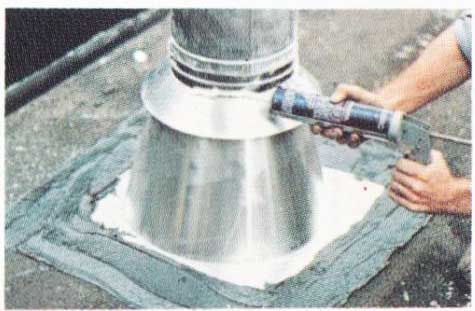
14. Seal gap between storm collar and pipe with caulking compound. (the purpose of the com po o nd, and I hc' tar j around flashing edges, is to seal installation trom inc leinc'nt vseather.)
15. Install noninsulateci stovepipe by pushing it up from below into chimney support Thc'n attach stovepipe bottom tc) c'xhaust flue on stove.
Starting and Operating A Wood-Burning Stove
To start up a fire in a wood stove, place a pile of kindling (thin slivers of quick-burning wood) over crumpled newspaper and top the pile with several light pieces of split wood. Open the draft regulator (and chimney damper if the stove has one), ignite the paper, and shut the stove door. After a few minutes, when the fire is going well, add larger and heavier pieces of wood-enough to fill almost the entire combustion chamber of the stove if you want a long burn. To avoid troublesome starting, use wood that is dry and fully seasoned.
As soon as the larger pieces of wood have caught fire, close the draft regulator two-thirds of the way or more.
The further you close it, the slower the burn rate and the longer the fire will last. Remember, however, that a slow fire tends to increase creosote buildup (see facing page). With a little trial and error in setting the stove's regulator, you will learn how to correct for external factors such as outside temperature, presence or absence of sunlight, and degree of wind chill. On very cold days, for example, you will find that the draft up the chimney is stronger than usual because the difference between inside and outside temperatures is greater. The result may be an excessively fast burn rate. To compensate, you should close the draft regulator or chimney damper a bit more than you would normally. Of course, if your stove has a thermostatically controlled regulator, these adjustments are made for you automatically.
Even with a well-designed chimney, a stove may occasionally back-puff. If this happens as you fire up the stove, try closing the draft regulator a bit. If backpuffing tends to occur when you add fuel, open up the regulator a minute or two before opening the stove door; increasing the draft will carry the smoke up the chimney.
Smoking can also he a sign of creosote buildup in the chimney; since this condition promotes chimney fires, it should be eliminated. Poor chimney design is another cause of smoking (see Chimney Installations, p.89). Fi ally, tight house construction and/or kitchen and bath exhaust fans can make a fireplace or non-airtight stove backpuff by restricting the air supply. Opening a nearby window a crack to increase air flow into the house will probably clear up the difficulty.
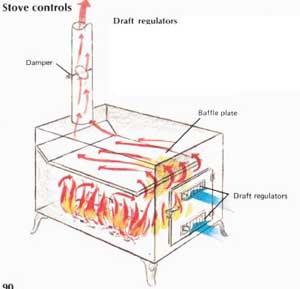
----------- Stove controls: Draft regulators and chimney dampers let you control the flow of air into the stove and up through the chimney; this, in turn, lets you regulate how fast the fire horns. Sometimes both are needed, but on airtight stoves draft regulators are sufficient for this purpose and the chimney damper may he omitted.
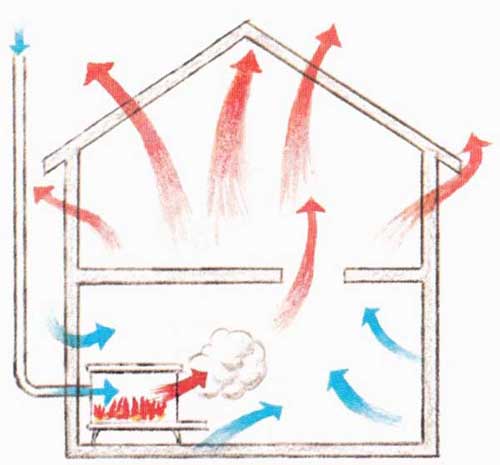
------------- Draft reversal: Warm stove air sometimes
chooses a path through the house rather than up the chimney. Air then flows
down chimney and into room. This is called draft reversal and is more common
with exterior chimneys. To counteract the effect, open a window near stove.
Also, before starting fire, ignite wad of paper in stovepipe. Once chimney
is warm, air will go up it.
Making your own stove
Small wood stove can be made from a 15-gal. closed-head heavy gauge grease drum after cleaning drum of any residue of grease, tolerances need not be precise. One weld and some furnace cement to hold stovepipe flange to stove top are needed. All other parts bolt on. Cut rectangular openings for fuel loading and ash removal; then cut doors from sheet metal to overlap the openings ½ in. all around.
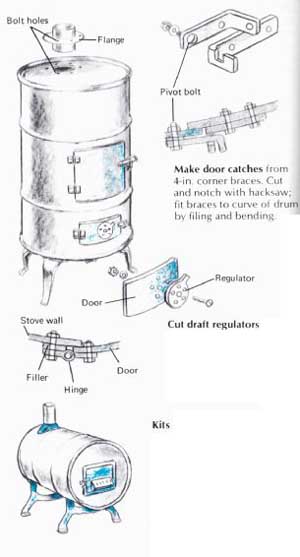
------- Make door catches from 4-in, corner braces. Cut and notch with hacksaw; fit braces to curve of drum by filing and bending.
-------- Cut draft regulators out of sheet metal; drill holes into them and through the doors in the pattern shown, then bolt in place. Door hinges should also be bolted on.
---------Kits for converting oil drums into stoves usually include legs, door assembly with draft regulator, and a 6-in. stovepipe flange. The picture shows a 55-gal. drum with parts bolted on. (For a longer stove life, a discarded water-heater tank might he substituted for the oil drum illustrated.)
Safety
Anything that is flammable--curtains, clothing, paintings, furniture, wall hangings--can catch fire if it is repeatedly heated to 300°F or above. Since a stove will soon bring nearby objects to this temperature, it is vital i adhere to the standard set by the National Fire Protection Association by keeping flammable materials it least 3 feet away from any wood-burning device.
Chimney fires are another hazard. Creosote, a wood by-product, tends to accumulate on chimney walls and p be touched off by sparks or flames from the stove. A chimney fire generally has a crackling or roaring sound. As the fire's intensity increases, the stovepipe may vibrate violently and turn red hot. If the chimney is well built, and all metal chimney joints have at least three screws, the fire will likely die out without causing any damage. In some cases, however, it may become so hot that it ignites nearby wall lathing, wooden beams, or ol tier structural members. In addition, chimney fires occasionally send clouds of sparks onto the roof, setting the roof aflame.
The first step to take in the event of a chimney fire is to stop the flow of air to the fire. This is easily done on an airtight stove by closing all draft regulators. With a fireplace you should have a large metal cover available that can quickly be put over the fireplace opening. With a leaky stove, a sopping wet blanket thrown over it may serve to stop the flow of air through the leaks. Have a bucket of water ready to wet the blanket down, since the moisture may quickly steam off and leave a dry blanket catch fire. As soon as you can, check the roof for sparks and wet it down with a hose if there is any sign of danger. If the chimney passes through upper floors of the house, inspect all areas adjacent to the chimney. You should certainly have several fire extinguishers handy in the event the fire starts to spread. Above all, if there is any hint that the fire is spreading beyond the confines of the chimney, call the fire department at once.
The best defense against a chimney fire is prevention. Clean your chimney regularly and operate your stove or fireplace so as to minimize creosote buildup. Details are given at right. Almost as important, you should make certain your chimney is in good running order. You will need to inspect it carefully to determine its condition. Do not assume that it is adequate simply because it has been in service for a number of years. Old stovepipes may not meet present-day requirements. If the chimney is made of brick, its flue may be cracked, the mortar may be partially disintegrated, or the chimney may have been built without a flue liner. If you have any doubts about the safety of a chimney, contact your local fire depart until; it can save you money and heartache.
The Creosote Problem
Creosote is a substance deposited on chimney walls by smoke flowing up the chimney. Chemically, creosote is a mixture of unburned organic compounds. When hot, it appears as a dark, viscous liquid. When it cools, it forms a solid, tarry residue that may later turn to a black ash that seems to grow from the inner surface of the chimney in leaf-like flakes. Creosote can burn, making it a fire hazard. It may also build up to such a point that it partially or completely blocks the air flow up the chimney, making the stove smoky and hard to light.
Contrary to what one might expect, the more efficient a stove is, the more apt it is to produce creosote. Leaky, inefficient stoves burn hot and fast, and the chimney walls become so hot that creosote does not have a chance to form on them.
If your chimney becomes clogged frequently by creosote, you may be running the stove at too low a burn rate. A smoldering overnight fire sends a lot of creosote forming smoke up the chimney. To get an overnight burn with a minimum of creosote, run your stove hot, until the wood in it has been mostly reduced to charcoal, before closing down the draft regulator to its nighttime position. Of course, some heat will be wasted during the initial high burn period (unless the stove is adjacent to a large thermal mass, such as a heavy masonry wall, that absorbs heat and reradiates it back into the room over night). A daytime approach, especially useful in the fall and spring when less heat is needed, is to make small, hot, quick-burning fires rather than cool, slow-burning ones. You will have to refuel the fire often, but combustion will be more complete.
Hot creosote will drip down the chimney. Ideally, it will flow into the stove and be burned up. But if the stovepipe is a poorly joined metal one, the creosote may drip out of the joints and make a disagreeable mess. To discourage this, it is preferable to install the stovepipe and chimney sections with crimped ends inserted down ward. This arrangement is typical of European chimneys but the opposite of traditional American practice.
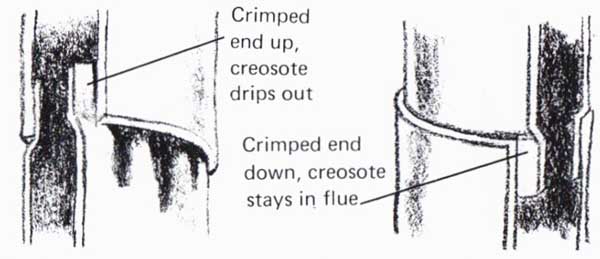
------- If your chimney runs straight up, you can inspect for creosote buildup by holding a mirror inside the stove when the stove is cold. Hold the mirror at a 45° angle directly under the flue opening. You can estimate the amount of creosote by the amount of daylight you can see. If you have a metal chimney with turns, T-sections installed at appropriate locations will permit you to check most of the chimney.
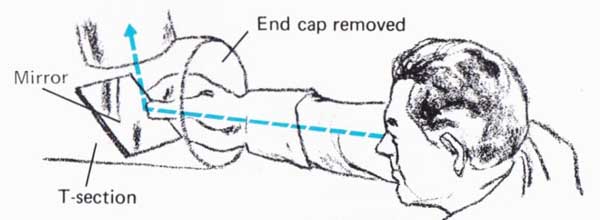
---------- A simpler but less reliable estimate can be made by tapping the stovepipe with a finger; the tap will produce a tingling sound if the pipe is clear but a duller, heavier sound if the pipe walls are laden with creosote.
Cleaning a chimney
The chimney on an airtight stove can become clogged in as short a time as two weeks if the stove is used carelessly. On the other hand, a stove used regularly and properly in a cold climate may need its chimney cleaned no more than once a year.
Cleaning a chimney is a messy job, and many prefer to hire a chimney sweep to do it. Some stove owners try to avoid the job by running a very hot fire once or twice a week to burn out accumulated creosote. The method is not reliable, however, and in addition such fires may eventually damage the chimney and break down its insulating properties. Chemical preparations are avail able that help disintegrate creosote when they are thrown on the fire. But first check with a stove or chimney dealer to make sure the preparation will not damage the chimney liner. The best cleaning method is to lower a stiff chimney brush through the top opening. Work the brush up and down to knock soot and creosote down the stove pipe and into the firebox where it can be cleaned out. The stove should be cold. It also should be shut tight, other wise clouds of soot may waft into the room. To better seal the doors, lap several pages of newsprint over the opening and close the doors onto the paper and latch them shut. (For the same reason, when cleaning a fire place chimney, cover the fireplace opening as tightly as you can.) Never use tire chains in a burlap bag. This can easily break tile or cement lined chimneys and internal mortar joints. Old-timers sometimes tied a rock to the top of a small evergreen tree and lowered the tree upside down by rope from the top of the chimney.
Fireplaces: Warm, Charming ... And Inefficient
A fire glowing and crackling in a fireplace generates an aura that no other type of heating can equal. The aroma of burning wood, the play of light and shadow, the warmth from the flaming logs evoke a sense of peacefulness, security, and contentment. It is no wonder that wood-burning fireplaces are prized features of homes and apartments. At the same time, there is no denying that the heating efficiency of most fireplaces is low-less than 10 percent in many cases compared with upward of 60 percent for the best airtight stoves.
Much can be done, however, to improve the performance of even the oldest and most wasteful fireplace. Among the simpler steps is to make more effective use of the damper-a pivoted metal plate that can be adjusted to control air flow in the chimney. When the fire is burning, open the damper just enough to keep the fire from smoking. This will reduce the amount of heated room air lost up the chimney. It is also important to close the damper completely when the fireplace is not in use. This simple precaution, observed winter long, may re duce your overall heating costs significantly. The reason is that with the damper open enough warm air can be lost up the chimney to turn the fireplace into a heating liability rather than an asset. However, do not close the damper when the fire is still smoldering; otherwise you will wind up with a house full of smoke and noxious gases. To prevent heat loss up the chimney when the fire is low but not yet fully out, place a tight-fitting cover made of sheet metal over the fireplace opening. Few manufacturers make these covers, but it is easy enough to cut one out yourself.
Fireplace efficiency can also be boosted with the help of special equipment. One useful accessory is the tubular convection grate illustrated on the next page. Also described on the next page is a heat-saving fireplace that convects air around the firebox via ducts or enclosed spaces and then sends the heated air hack into the room. Prefabricated units often incorporate this design. Modern masonry units, too, frequently use the same approach. To some degree, however, these improvements change the character of the fireplace, making it some what like a circulator-type stove and diluting the esthetic appeal that makes a fireplace attractive. Another effective device for raising fireplace efficiency is airtight glass doors fitted over the fireplace opening. These doors cut down on the amount of warm air lost up the chimney but also isolate the fireplace from the room; you can see the fire, but you lose intimacy with it.
Most people eventually develop their own techniques for building fires, yet there are nuances that are some times overlooked. When the logs are too close, not enough air will flow between them to support efficient burning; when they are too far apart, the logs will not absorb enough heat from adjacent logs to reach combustion temperature. Adjust the spacing for minimum smoke and maximum burn rate. A poker and tongs will come in handy for this chore.
A common problem is a fireplace that back-puffs smoke into the room when the fire is started. An effective remedy is to hold a wad of burning newspaper directly under the chimney flue before lighting the main fire. This pre-warms the walls of the chimney, making it more apt to draw properly. If the problem persists, the house may be overly air tight (see Draft reversal, p.9 Open up a nearby window an inch or two until the fire is burning well. Check the furnace and water heater draft hoods to make sure replacement air is not also being pulled down their chimneys. If it is, contact your gas utility or state energy office for advice. (An inadequate chimney, poorly designed fireplace or house exhaust fans, may also be to blame.)
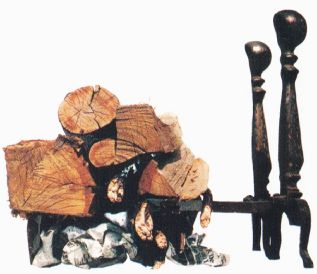
----------- To start the fire, first pile kindling (thin pieces of dry wood that burn quickly) on balls of crumpled newspaper placed between (he andirons. Top the kindling with light pieces of split wood and two or more logs. Open the chimney damper and ignite the newspaper. Caution: Never pour kerosene or other flammable liquid on the wood to help start the fire.

----------- Implements and accessories for the fireplace
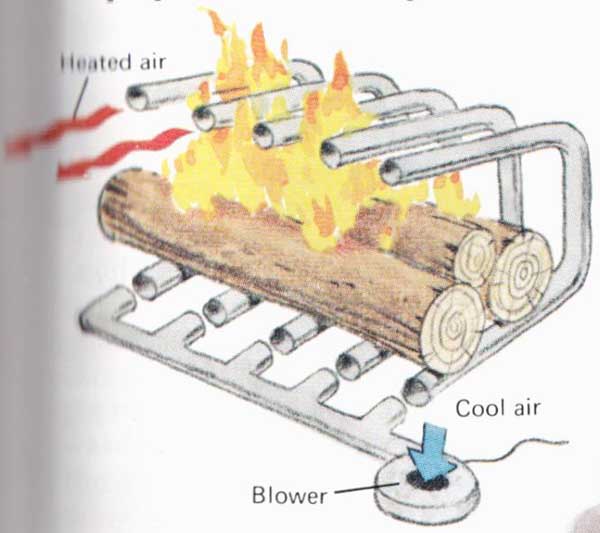
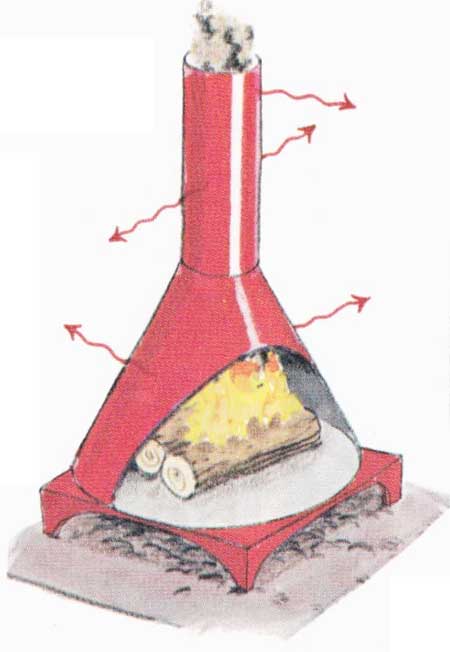
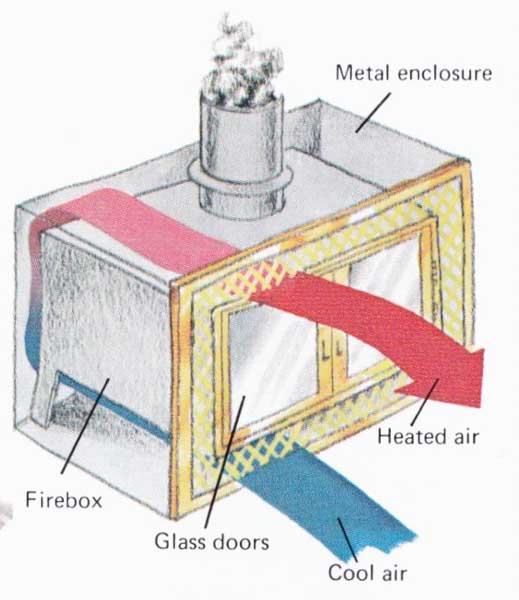
-------- Equip. for Improved Efficiency
Tubular convection grate, used in place of an ordinary grate of and lit its, serves as a ready made heat Si I luger br a fireplace. [ lire hits the air inside the tubes, losing it to how I) (O I IOfl ut oh the top openings. Etli tiny is inreased, since warm air c unto the room rather than up Ito i hirnne A luIoc altar lied liii' bottom openings of the ii c' wtll speed heat transfer.
Freestanding fireplace is easier to install than a built in unit. Like a metal stoce, it radiates heat in all di rec Ii uris. I fowever, wit Ii oot ma sours to slow heat transler, the tire in ust be te ndecl mc) rc oh t c'n than with a masonry unit.
Prefabricated fireplace usc a special metal trrebox so well insulated that the unit can be installed with "zero clearan e," that is, directly next to wooden framing. Pre-fabricated fire pla es otten come with airtight glass doors in front to reduce heat loss and a system ot air cluc Is and spares to irc ulate room air around the firebox and then out into the room again by convection. Like any wood-burning heater, performance is improved if the chimney is installed cr11 irely inside the house.
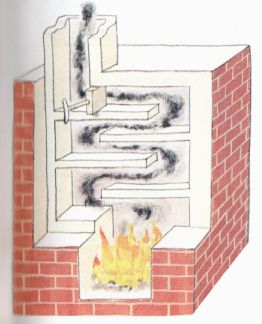
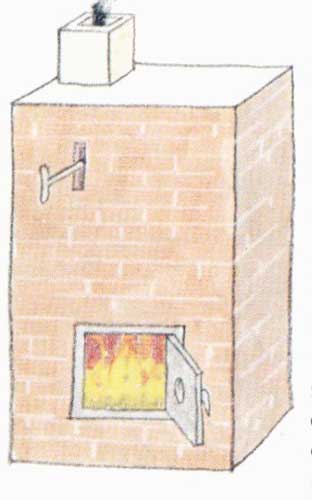
----------- Masonry and ceramic stoves
Large masonry and ceramic stoves evolved over the years from continued attempts to improve fireplace efficiency. Originally developed in Europe, and later imported to the New World by the Pennsylvania Dutch and other early settlers, the stoves are vastly more efficient than the old fashioned fireplace (Their obvious advantages helped inspire Ben Franklin to design his famous fireplace stove ) Shown at left is a massive Russian-style brick stove teat un rig a serpent lie arrangement of exhaust ducts to capture the heat before it can esc ape up the chimney. The stove is built entirely within the house. It is tired for a brief time with a very hot fire arid damped only atter the wood has burned down to smokeless coals. The heat I rum the tire is absorbed by the tiuasonry, whn h sloc ly reradiates it into the room. I mm one firing enough heat an be tttrod in I ho masonry to warm a room for two days, and the heat given off remains remarkably even for that period. Since I lie fire burns hot little Creosote forms in the exhaust, making the stove one of the tew wood burning devices that can be lelt untended br long peru)ds without olle ting creosote.
--------
Making your own bellows
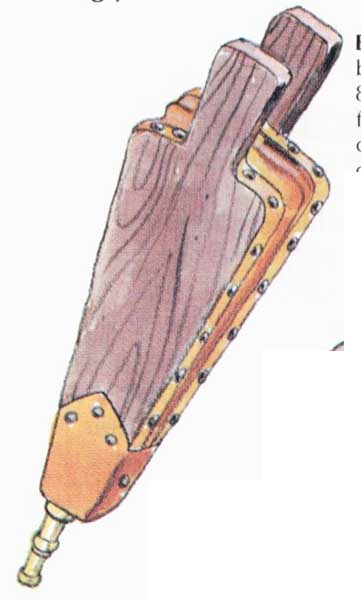
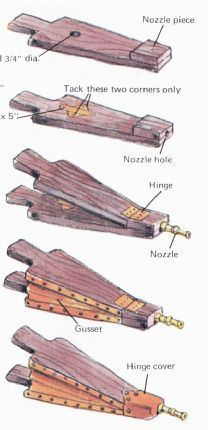

Basic materials for a good-looking bellows are a It. length of ½- by 8-in. white pine a rid a few square feet of supple leather, such as split cowhide. For a nozzle, use 3/8-in. copper tubing or an old garden hose nozzle with its insides removed. When gluing, use casein or plastic resin, not white glue. Some ½-in. lacks and several dozen upholstery nails are also needed.
1. Cut bellows halves and nozzle piece from wood.
2. Cut valve parts from leather and tack over hole in lower bellows half.
3. Glue nozzle piece to lower bellows half.
4. After glue hardens, drill hole br nozzle; then glue nozzle into hole.
5. Cut hinge from leather and tack into place.
6. Prop bellows handles 4 in. apart. Tack cloth to edges where gusset is to nailed; cut cloth along edges and remove it.
7. With cloth as pattern, cut gusset from leather. Starting from handles, nail gusset to bellows.
8. Make hinge over pattern out of cloth; following pattern, cut cover from leather and then nail cover over hinge.